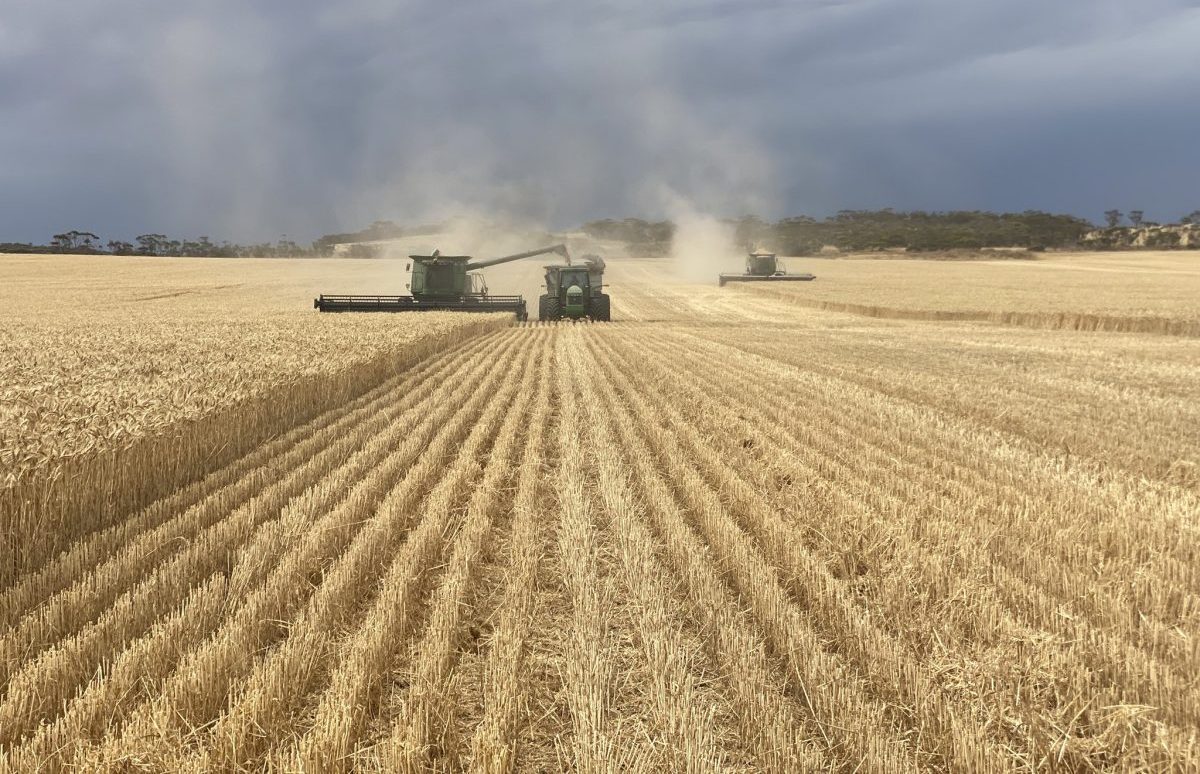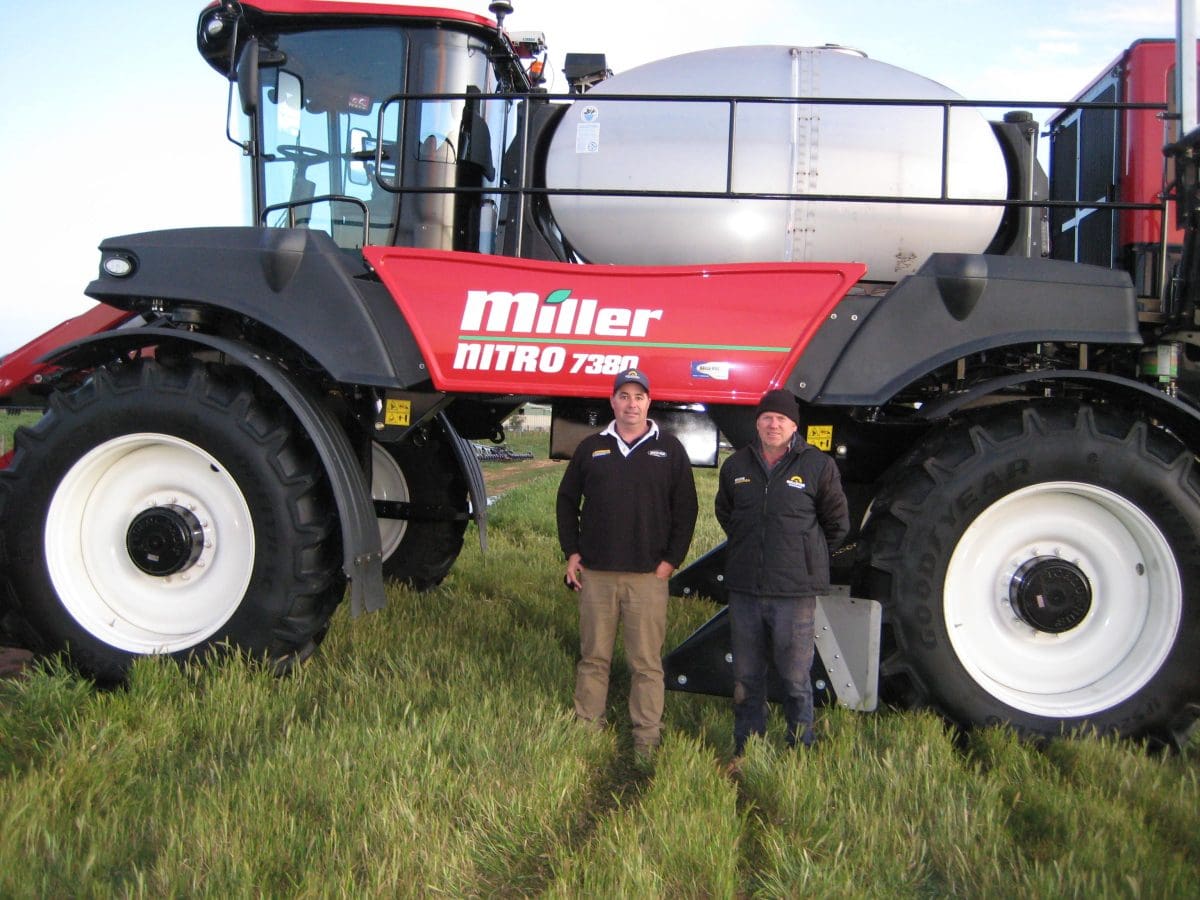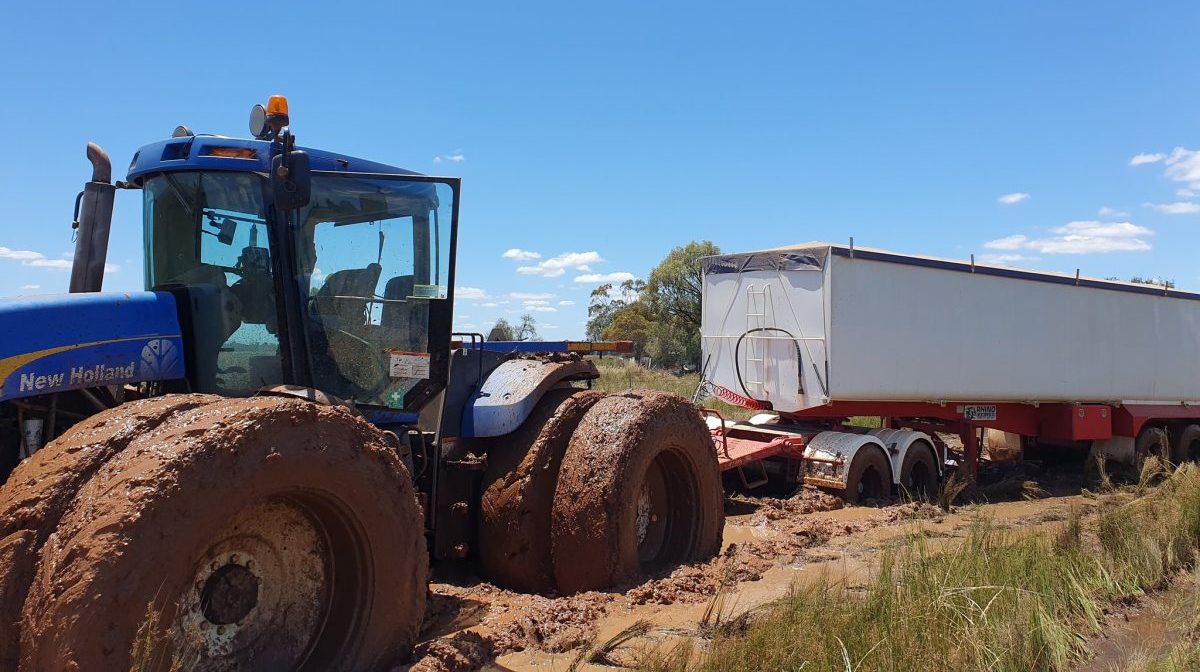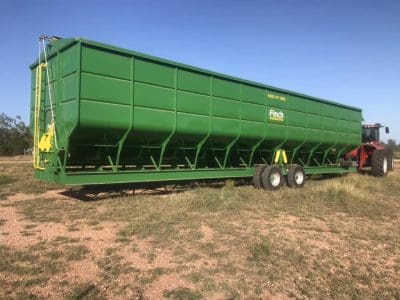
Wheat crops have set new yield records for Shipard Ag on South Australia’s Upper Eyre Peninsula. Photo: Ben Shipard
A GROWER case study from each mainland state points to why Australia is on track to set new records for wheat and canola production this year.
ABARES last week forecast wheat production at 36.6 million tonnes (Mt), 300,000t ahead of the record set last harvest, while canola seen at 7.3Mt is 500,000t in front of last year’s record.
While heavy and successive rain events have adversely impacted yield prospects in much of New South Wales, the wet year has set growers interviewed by Grain Central up for bumper harvests in other states.
Take a trip from west to east for a snapshot of how harvest is progressing across the country:
Tracy Lefroy, Bindi Bindi, Western Australia
Cropping: 4300ha cash crops plus sheep.
Rainfall: Annual average 400mm, with 440mm received to date, most within the growing season.
Yield: Cranmore’s long-term average for wheat is 3.3t/ha, and canola 1.6t/ha.

Kristin Lefroy during harvest this week on the family’s Moora farm.
“We’re still harvesting, but the yield is looking to be about 5t/ha for wheat, 2.2t/ha for canola and 5.2t/ha for barley,” Mrs Lefroy said.
Record yields are possible.
“We are hoping to beat 2018, which was our highest- yielding cropping year.
“Barley and hay yields surpassed 2018, and canola was about the same, so it is all hanging on the wheat we have remaining to harvest – it is looking good at the moment.
“Our previous record for wheat was 4.5t/ha.
Grades: “Currently our quality profile of APW wheats and malt barley mean that there are still good pricing opportunities, while some of our lower-quality grain will find a home in the harvest pool.”
Harvest summary: Mrs Lefroy said this year has been characterised by good rainfall at the start of the growing season, then a dry patch which encouraged plant roots to “do a bit of exploring”.
“That meant that when the soil got wet at the end of winter and the start of spring, the plants had robust root systems which were able to cope with the wetter conditions.
“It has been one of the best growing seasons I can recall.
“We are about 30pc of the way through our wheat, so we are probably 80pc of the way through our cropping program.
“The mild spring, combined with the welcome high yields, have definitely slowed our progress through harvest this year.
“We are certainly not complaining; these are good problems to have.”
Marketing: The strategy of Tracy and husband Kristin Lefroy was developed in consultation with commodity adviser Pete Rees of MarketAg.

Tracy Lefroy.
“We approach grain marketing in the same way that we approach farming; recognising the benefits of diversity.
“We grow a number of different crops, including noodle wheat and APW, barley and GM and non-GM canola, as well as having sheep.
“Similarly, we run a diversified marketing strategy, with many different tools including swaps, cash sales and pools.”
Mrs Lefroy said they used swaps conservatively this season, given the run-up in prices associated with the Ukraine invasion, and were well-positioned for production for most of the season.
“That meant we were able to take advantage of strong cash markets from May to August to lock in sales.”
Ben Shipard, Kimba, South Australia
Cropping: 4000ha in total of wheat, barley, lentils and lupins.
Rainfall: Annual average 320mm; year to date 500mm plus, including record January rainfall for the Kimba district of 180-220mm.
Yield: The long-term average wheat yield is 1.7t/ha, and around halfway through the wheat harvest, the yield range is 3-5.4t/ha.
“Our previous best yield was 3.8t/ha for just one paddock,” Mr Shipard said.
He farms with his brother and father, and said wheat from Shipard Ag’s farm north-west of Kimba was yet to be harvested when he spoke with Grain Central on Monday.
This farm is expected to yield around 2t/ha, and will therefore drag down this harvest’s average yield.
“We have harvested the best wheat crops first to get them in the bin before any rain can damage them.”
Shipard Ag’s average lentil yield is 1t/ha, and 2.1t/ha is in sight this year, while barley normally averages 2t/ha, and 3.2t/ha is this year’s average.
Grades: Wheat harvested to date has been mostly ASW, with a little bit of APW, and falling numbers have not been a problem, with samples being in the mid 400s.
Harvest summary: The mild spring has made Shipard Ag’s harvest four weeks later than normal.
“The spring rain was pretty good, and we didn’t have a day over 30 degrees until late November, when we normally get them in August.”
Lentils got two fungicide sprays when one or none is the norm, and Shipard Ag is now around two-thirds through harvest.
Mr Shipard said the absence of heat has allowed crops to fill to their full potential.
“Crops had time to run their race.”
Marketing: “We try and sell 50pc to Viterra and 50pc to T-ports to keep competition alive.”
Gene Fuller, Yaapeet, Victoria
Cropping: 3000ha in total to wheat, barley, canola, lentils and lupins.
Rainfall: Annual average 300mm; year to date 600mm plus.
Yield: Long-term average wheat 2.7t/ha and canola 1.3t/ha against an estimated 4.5t/ha for wheat and 3t/ha for canola this year.
“Canola was exceptional for our area; I don’t think I’ll ever see yields like it again,” Mr Fuller said.
“All our oil was 46-47pc; canola has been the shining light.”
Grades: Around two-thirds of the barley harvested made BAR1, and the balance BAR2.
BAR1 requires a minimum test weight of 62kg per hectolitre, and Mr Fuller said weight has been the problem.
“Some was 60-61kg, and nothing was over 63kg.”
The Fullers plan to start harvesting wheat this week, and Mr Fuller said indications from crops harvested in the district point to Hard wheat of 11.5pc protein or more, often a dominant grade in the region, being a rarity this harvest.
“I’m hearing there’s a lot of ASW and APW; I haven’t heard of too much H2.”
Distorted wheat grains as caused by rust is expected to push some loads into off-spec segregations.
“This year was our biggest year ever with fungicides,” Mr Fuller said in a McIntosh Distribution media release.
“We had a lot of rust in the wheat and lentils.
“Some paddocks had up to three applications, whereas we usually get away with none in the wheat and one in the lentils.
“We were on to the disease early in the barley, but it still had two applications.’’

Gene Fuller (right) with Kent Hansen of Belle-Vue Trading, Swan Hill and the Fullers’ new Miller Nitro 7380 sprayer bought to help with the hectic fungicide program needed to keep disease in check this year. Photo: McIntosh Distribution
Harvest summary: Harvest in the southern Mallee is usually over by Christmas, but is expected to run well into January, and is around one-third through so far on the Fullers’ Ochre Farm.
“We usually start in the second week of November on lentils, and then barley, canola and wheat, and we finish on lupins; this year lentils will be last.”
“We’ve done canola and pretty well done our barley, and we should be into our wheat this week.
“Our lentils have wanted to stay green, and the cool weather has made for a pretty narrow harvest window each day.
“We need a week of 30-degree weather; surely that’s not too much to hope for in December.”
Marketing: Lentils are stored on farm and sold for export out of Port Adelaide or Victoria, and cereals are generally warehoused with GrainCorp and sold on spikes in the market throughout the year.
Mark Mortimer, Tullamore, New South Wales
Cropping: Aimed at 1600ha, but wet conditions in June meant 20pc could not be planted, and around 10pc was sown but did not germinate.
Rainfall: Average 500mm, and year to date 931mm.
Yield: Wheat yields look like being half of what they were last year and the year before.
“The past two years for us have been excellent, so 4-5t/ha, but this year the price is better.”
“We’re in our good paddocks now and they’re going 1.7-2.7t/ha,” Mr Mortimer said.
“Yields under 2t/ha are below our average, but the yields have been OK, although the amount of grain in the bin doesn’t match the amount of straw in the paddock.”
“People are surprised at how low some of the yields are, down to maybe 1.2t/ha.”
While some growers in the most marginal of NSW country out from Tullamore are bringing in wheat crops of 5t/ha on light country, Mr Mortimer said heavier grey Bogan River country became inaccessible.
If it produced crops, yields are low, and show the signs of a sodden season.
“If you sowed it, you couldn’t get near it again, so no herbicide, no fungicide, and no fertiliser if you couldn’t fly it on.”

Getting bogged has been a hallmark of the current harvest in eastern Australia, and Mark Mortimer has had plenty of experience at vehicle recovery on his heavier country. Photo: Mark Mortimer
Grades: The Central West slopes and plains of NSW can produce Hard or even Prime Hard wheat in volume, but last year’s wheat harvest was a wet one also, with widespread downgrading to SFW.
Following heavy rain last month, a run of around 17 dry days has allowed significant progress to be made, and Mr Mortimer said this year produced a mixed bag of wheat quality.
“We’ve had GP1, AH9, H2 and AUH2.”
The presence of distorted grain, likely a function of rain-related disease, and low falling numbers have been evident in some loads, while light weight shows the tough season barley has had.
“We stripped a couple of hundred tonnes of barley with a test weight of 51kg, when the minimum for F2 is 60kg.
Harvest summary: Harvest gets under way by late October, but this year started with canola on November 18.
“We’re a smidge over half way,” Mr Mortimer said last week.
“We have a range of country, and on some of our light sandy red soil, it’s packed down because of the rain, and we can use a road train in the paddock.
“On other country, we can bog empty trailers.”
Marketing: With Manildra Group’s Bogan Gate site within 50km, and GrainCorp Tottenham closer, Mr Mortimer has been sending grain to both depots.
The family runs the Centre Plus Merino Stud and a commercial flock, and is storing the lightweight barley on farm to feed to sheep.
Ross Faint, Clermont, Queensland
Cropping: 1200ha in total of wheat and chickpeas plus cattle.
Rainfall: Annual average 500mm, with around 700mm received to date, including 160mm in late April to set up a bumper winter crop.
Yields: Like many Central Queensland growers, Mr Faint said this year looks like being a record for wheat yields, and returned around 2.9t/ha average yield.
“We planted wheat for the first time in about 10 years because we figured it was going to be wet,” Mr Faint said.
Chickpeas yields at around 1.8t/ha were not so impressive.

Ross Faint purchased a new field bin which arrived in September to help handle the bumper wheat crop.
Grades: Around two-thirds of the wheat area was harvested prior to 86mm of rain falling last month.
“Most went H2, so minimum 11.5pc protein.”
“Chickpeas got hammered with wet weather, and I had to buy a grader.”
It has allowed the Faints to grade out defective seed, and avoid the discount of roughly 50pc between the top CHKP1 grade and the mould-tolerant CHKPM one.
Harvest summary: Timing of CQ’s harvest this year was “about normal”, even though the winter crop was planted late because country had to dry out after big rain in April.
“Our wheat harvest was good, but chickpeas were difficult.
“I wouldn’t put chickpeas through the auger of the chaser bin, so we had to take trucks to the header.
“We’ll probably continue to grow wheat now, even though we don’t get consistent rain here, and you need two rain events to grow a good wheat crop.”
Mr Faint said chickpeas were their regular winter crop, as they can be sown deep into subsoil moisture, not an option for wheat.
“We’ve grown chickpeas just on moisture and no rain and gotten something back.
“If you get three years out of 10 with decent winter rainfall, you’re doing alright.”
Halfway through harvest, 86mm of rain fell and impacted quality on the last of the wheat and all the chickpeas.
The rain has been ideal for summer-cropping prospects.
“We are close to planting sorghum, and the beautiful soaking rain we’ve had will give us enough moisture to plant on.”
Marketing: All milling wheat and some chickpeas have been delivered to GrainCorp’s Mt McLaren site, while feed wheat and some chickpeas were delivered to the Sizer Cogill facility recently opened at Mt McLaren.
NOTE: Tasmania’s harvest is yet to start and a report on activity in the island state is scheduled to appear on Grain Central in February.

HAVE YOUR SAY